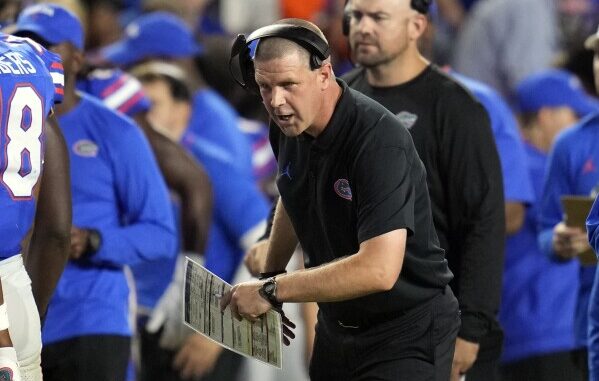
Sometimes what looks like a blunder on the surface turns out to be a calculated decision once you dig into the rulebook. That’s exactly what happened with Florida’s late-game timeout that had fans scratching their heads — and critics ready to pounce on head coach Billy Napier. But in reality, Napier’s timeout wasn’t a mistake. It was actually the correct, strategic move under NCAA rules.
Let’s rewind the sequence. With the clock winding down and tension thick in the air, Florida offensive lineman Austin Barber lost his helmet during a play. By rule, any player who loses his helmet (without it being caused by a penalty) must leave the field for at least one play. Normally, this doesn’t cause major disruption — unless it happens during a critical drive with the clock running and limited timeouts remaining. That was exactly the Gators’ situation.
If Florida had simply let Barber sit out a play, it would’ve triggered a mandatory 10-second runoff from the game clock. This is the NCAA’s way of preventing teams from faking injuries or creating unnecessary stoppages late in games. The Gators couldn’t afford to lose those precious seconds — not in a tightly contested finish where every tick mattered.
So Napier had two choices:
1. Let Barber sit out, take the 10-second runoff, and try to regroup with a replacement lineman under pressure.
2. Use his timeout to “buy back” Barber’s participation and eliminate the runoff.
Napier chose option two — calling a timeout.
That move, while seemingly odd in the moment, was actually the only way to keep Barber in the game without the clock penalty. Fans at first thought Napier was stopping the clock unnecessarily, or worse, making another late-game management error. Social media lit up with criticism, with fans replaying the moment in disbelief. But the details tell a different story.
Here’s where it gets even more interesting: when a team is offered a 10-second runoff and declines it, the clock still stops. This means that calling a timeout to avoid the runoff doesn’t disadvantage you more than declining it would — but it preserves your key player on the field.
Napier understood that perfectly. Instead of risking confusion or miscommunication with a substitute lineman on a crucial play, he used his timeout strategically. Barber, one of Florida’s most experienced protectors, stayed in. The offense kept its rhythm. It was a small decision that demonstrated situational awareness — the kind of nuance that often separates impulsive reactions from smart coaching.
In hindsight, Napier’s move shows that not every timeout that looks “strange” is wrong. The rules around the 10-second runoff are complicated, and in the heat of a game, coaches have to make split-second calls balancing personnel, clock, and strategy. This time, Napier read the situation exactly right.
Florida fans might be used to scrutinizing every decision in close games, but this one deserves credit, not criticism. What appeared to be another questionable clock management moment turned out to be a textbook understanding of NCAA timing rules.
So, yes — revisiting Florida’s strange timeout at the end of the game proves something rare in modern sports debates: Billy Napier was actually right. Sometimes, the ru
lebook vindicates the coach.
Be the first to comment